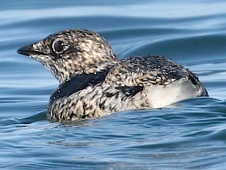
The climate of our planet is changing rapidly because of human activities, especially the burning of fossil fuels and destruction of forests. We can already see direct impacts of climate change on biodiversity, while other threats may be made much worse. Many species may have to shift their ranges to survive, and considerably more losers than winners are expected. Inappropriate or poorly planned mitigation measures (such as biofuel cultivation) could also do grave damage to biodiversity.
Climate change is already affecting birds in diverse ways View case study list
View case study list
The Earth is undergoing profound changes to its climate. There is little doubt that this results from human activities, mainly the burning of fossil fuels (![]() ). Climate change is expected to have far-reaching effects on the Earth’s natural systems. At the species level, climate change may affect distribution, abundance, behaviour and other factors, with different species affected in different ways (
). Climate change is expected to have far-reaching effects on the Earth’s natural systems. At the species level, climate change may affect distribution, abundance, behaviour and other factors, with different species affected in different ways (![]() ,
, ![]() ,
, ![]() ,
, ![]() ,
, ![]() ,
, ![]() ,
, ![]() ,
, ![]() ). Climate change is expected to act in combination with other threats, often making their impacts considerably worse. Furthermore, inappropriate or inadequately planned mitigation measures may also have detrimental impacts on biodiversity. For example, clearance of natural habitats to cultivate biofuels (as alternatives to fossil fuels) increasingly threatens birds and other biodiversity.
). Climate change is expected to act in combination with other threats, often making their impacts considerably worse. Furthermore, inappropriate or inadequately planned mitigation measures may also have detrimental impacts on biodiversity. For example, clearance of natural habitats to cultivate biofuels (as alternatives to fossil fuels) increasingly threatens birds and other biodiversity.
Many species will suffer from range shifts and losses, and some will become extinct View case study list
View case study list
While some species may benefit from climate change, much larger numbers are predicted to suffer. Modelling studies indicate that the ranges currently occupied by many species may become unsuitable for them as climate changes, with the climate space suitable for particular species likely to shift in latitude or altitude (![]() ,
, ![]() ), contract (
), contract (![]() ,
, ![]() ), or even disappear. Species whose climate space disappears or both contracts and shifts substantially will be of particular concern (
), or even disappear. Species whose climate space disappears or both contracts and shifts substantially will be of particular concern (![]() ). Studies suggest that many species will not be able to keep up with their changing climate space. Both local and global extinctions are likely, even of species currently considered safe. The most susceptible species will be those with restricted ranges, bounded distributions (for example on mountain-tops, small islands or along coasts:
). Studies suggest that many species will not be able to keep up with their changing climate space. Both local and global extinctions are likely, even of species currently considered safe. The most susceptible species will be those with restricted ranges, bounded distributions (for example on mountain-tops, small islands or along coasts: ![]() ), specialised habitat requirements or poor dispersal abilities (
), specialised habitat requirements or poor dispersal abilities (![]() ). While bird species differ greatly in dispersal abilities, most are relatively mobile compared to other organisms—which will be impacted even more severely.
). While bird species differ greatly in dispersal abilities, most are relatively mobile compared to other organisms—which will be impacted even more severely.
The extent of warming will be critical View case study list
View case study list
The size of the extinction crisis caused by climate change will be directly related to the degree of global warming (![]() ). A global average temperature rise of 2°C in the next century will almost certainly lead to numerous extinctions, but leave open some practical management options for the conservation of biodiversity. Temperature rises beyond this level are predicted to lead to catastrophic extinction rates, with few management options and a bleak future for both biodiversity and people.
). A global average temperature rise of 2°C in the next century will almost certainly lead to numerous extinctions, but leave open some practical management options for the conservation of biodiversity. Temperature rises beyond this level are predicted to lead to catastrophic extinction rates, with few management options and a bleak future for both biodiversity and people.